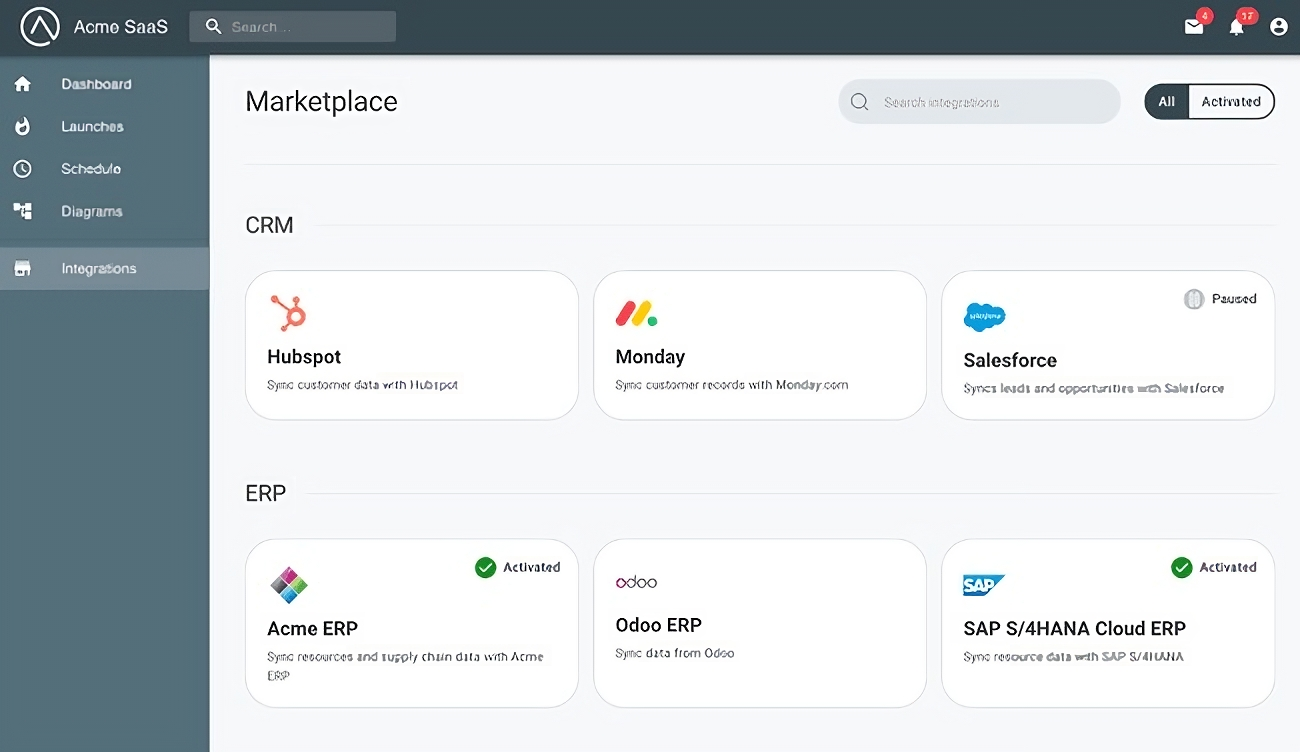Trending News
16 October, 2024
8.38°C New York

IT teams today have to juggle an enormous number of tools, apps and systems. The average company was using 130 software-as-a-service (SaaS) apps as of 2022, according to Statista — a volume that’s impacting productivity. Eighty percent of companies responding to a recent MuleSoft poll said that app integration challenges are slowing down their organization-wide efforts, leading to data silos and disconnected departments.
Michael Zuercher says that he experienced the SaaS app integration headache firsthand while bootstrapping his first startup, Zuercher Technologies, a public safety agency software provider.
“We built around 600 integrations to customers’ other software. It was absolutely necessary, but became a significant burden and eventually ate up over half of our R&D capacity,” Zuercher told TechCrunch in an email interview. “Throughout this time, we realized integrations remained a complex, unique and largely unsolved problem for software companies.”
One solution is what’s known as integration platform as a service (iPaaS), a cloud-based type of service that helps organizations tie in and unify their apps, processes and data from a single pane of glass.
The iPaaS market is well-established at this point, having generated $3.47 billion in revenue in 2020 on its way to more than $9 billion by 2025. And companies have embraced iPaaS; one survey from 2021 found that 66% of corporations will invest in iPaaS to address their data integration and automation challenges.
iPaaS startup and incumbent offerings abound. A few include Integration.app, which uses AI models to reconcile disparate apps and services; Digibee, which recently raised $60 million in venture capital; and Amazon’s recently launched AWS AppFabric.
Zuercher thought he could — and still thinks he can — do better.
Today, he leads Prismatic, an iPaaS startup designing a solution to help business-to-business (B2B) SaaS companies connect their products to the other products their customers already use. Zuercher co-founded Prismatic with Beth Harwood and Justin Hipple in 2019, aiming to streamline app integration development to let SaaS companies more easily connect to third-party software.

“SaaS companies are spending huge amounts of time and resources on integrations,” Zuercher said. “Prismatic reduces that burden by helping SaaS companies easily build integrations, deploy and manage those integrations at scale, and embed them in their solutions so their customers can self serve.”
Prismatic offers a low-code integration designer, a native development environment, a management console and a marketplace where customers can toggle and configure integrations. The platform recently launched an integration designer and new, expanded API connectors, “doubling down” on more developer-focused functionality, Zuercher says.
“We built Prismatic from the ground up to serve SaaS companies — not businesses building internal integrations — so features SaaS companies need, like developer-focused tooling, customer-specific configuration, version control, embedding and scalability were included from day one,” Zuercher said. “Prismatic’s embedded iPaaS provides a way for SaaS vendors to provide powerful integrations as a native part of their products, reducing the burden of integration on IT departments.”
Zuercher wouldn’t reveal exactly how many customers Prismatic has at present. But he said that the client makeup ranges from startups to Fortune 100 companies and that it drove annual recurring revenue growth throughout 2023.
In a possibly optimistic sign, Prismatic just today closed a funding round — a $22 million Series B — led by Five Elms Capital, the Kansas City–based growth equity firm, bringing Prismatic’s total raised to $34 million. The new cash will be put toward growing the startup’s ~50-person team, expanding R&D and enhancing Prismatic’s existing tools and software.

“We decided to raise equity to capitalize on the growth we saw in 2023 — a time when many SaaS companies were taking a step back,” Zuercher said. “In 2023, we saw strong, consistent growth throughout the year. We’re more confident than ever that our product is making an impact for B2B SaaS teams, and this funding will accelerate and expand our efforts.”
“Prismatic’s stellar growth since its Series A, achieved in less than a year, has solidified the indispensable role of embedded iPaaS in B2B SaaS companies,” Austin Gideon, principal at Five Elms Capital, added in a canned statement. “We’re seeing intense demand across our portfolio of B2B software companies for a platform to help augment integration capabilities. Scaling software companies are able to realize strong returns on investment by utilizing Prismatic’s platform, allowing teams to remain focused on delivering new products to customers. Partnering with this team again for the Series B gives us the opportunity to make meaningful advancements and improvements in the future of SaaS.”

Instagram said today that it is expanding its marketplace tool to connect brands with creators for paid partnerships or ads in eight new countries. The new markets that will get access to this marketplace include Canada, Australia, New Zealand, the United Kingdom, Japan, India, and Brazil.
The company first started testing this platform in the U.S. in 2022. It said that since then it has onboarded “thousands” of creators and brands. Last year, the social media company added API features for creator outreach and structuring briefs and invited agencies to use the platform.
Meta added that apart from making the platform available to the brands in these eight countries, it will also invite Chinese export brands to connect with creators outside of China.
The company said that over the next few weeks, it will invite both brands and creators to join the marketplace in these eight new regions. Marketers can approach creators for a paid partnership or even a partnership ad, which allows advertisers to boost organic content as ads.

Once creators join the platform through the professional dashboard in the Instagram app, they can highlight their content and list brands and interests that would be relevant to them.
On the marketplace, Meta helps brands match with relevant creators for a particular marketing campaign through its machine learning algorithm. Companies can also search manually for creators and apply filters — in creator and audience categories — and ad experience to refine the results.
Creators will see all the requests and conversations with brands initiated through the marketplace in a new folder on Instagram called “Partnership messages.” They can review the details of the marketing campaign within the app as well.

Instagram’s rivals like Snap, YouTube, and TikTok all offer creator marketplace functionality. Besides that, some startups are trying to solve the problem of connecting brands with creators. Accel-backed Catch+Release is helping brands better discover licensable content. Agentio, which has raised $4.25 million in seed investment funding co-led by Craft Ventures and AlleyCorp, has built a platform to organize the process of YouTubers selling ad slots in their videos. Breaker, which has Marc Benioff; a16z/TxO; ex-CEO of TikTok Kevin Mayer; and R/GA Ventures as investors, connects record labels and artists to influencers to run promotion campaigns.

Autonomous systems have become essential to military operations around the world, but there’s almost no infrastructure available to unify these systems at scale. As a result, operators in the field are often limited to a one-to-one relationship with a single system at a time. Picogrid wants to change that by building a platform that can integrate everything from sensors and cameras, to drones, weapons systems and robotics.
“This problem is really innate to how the military operates today,” Picogrid co-founder and CEO Zane Mountcastle explained.
Part of the problem is simple inefficiency: If a soldier only has access to, say, an infrared long-range camera, they might be able to spot a target on the front lines but be unable to do anything about it. The question then becomes one of transforming stovepipe, standalone systems into an integrated network that can be leveraged however the end user needs.
Mountcastle intimately understands the problem: He witnessed many of these issues firsthand at his previous venture, a defense services company called Mission Mule, which he co-founded in 2018. Working alongside members of the military, he built field sensors and autonomous systems and deployed them at military bases across the U.S.
“To see how difficult it was to field these systems into real operations was really, really shocking to me,” he said. “I spent weeks at a time with these folks beating around the desert in 4×4 [vehicles], doing these different projects, and I pressed them the entire time with, why don’t you make your life easier? Why don’t you do something? A lot of it seemed like very low-hanging fruit to me. I kept getting the same response or over and over, which is, ‘We don’t have access to that.’”
He and his co-founder, Martin Slosarik, are aiming to change that with Picogrid. The four-year-old startup has developed a suite of hardware and software aimed at integrating the archipelago of devices that have become essential to everything from protecting soldiers on the battlefield to safeguarding critical infrastructure. The core of Picogrid’s technology is a cloud-based API called Legion, a middleware solution that is used to pull data from many discrete, third-party systems, as well as two hardware products, Lander and Helios.
Lander is designed for long-duration, stationary operations and missions, while Helios is optimized for mobility, like a frontline. The hardware isn’t an extraneous add-on to the software stack; it’s part of how Picogrid aims to put Legion into the hands of end users. Both platforms are designed to provide power, communications and compute for the startup’s growing list of sensor integrations.
To help scale their vision, the company just closed a $12 million seed round led by Initialized Capital with participation by Starburst Ventures, Credo Ventures, Giant Step Capital, Domino Ventures and Alumni Ventures.
“It’s really a matter of multiplying the effectiveness of every individual soldier by giving them access to very large fleets of systems of whatever type they need for that specific job,” Mountcastle said.

Picogrid has scored over a dozen federal contracts and currently has over forty hardware installations across six military bases U.S., as well as installations in Ukraine. The company will be deploying installations at a seventh and eighth military base in the next few weeks. The startup has a few small contracts outside the military, in the wildfire and utility space, but it’s mostly focused on military applications.
As the funding round indicates, Picogrid is planning big things for 2024. That includes opening a second manufacturing facility in Oklahoma and building out additional hardware platforms. Significantly, the company is also planning on taking the Legion platform and opening it up for developers to build on. To date, Picogrid has been building integrations in-house. But Mountcastle said the team realized that for the system to scale, they would need to give full access to third parties to build into it.
“You can probably imagine how that would make a lot of people military uncomfortable because it’s never really been done,” he said.
Indeed, that is far from the status quo in the defense industry, which is typically wary of open systems from both a cybersecurity standpoint and a reliability standpoint. But Mountcastle said much of the new seed funding will go toward ensuring that Legion remains secure, even as it opens up.
Providing access to third parties could also help solve another pervasive problem in the defense industry: transitioning technology developed by startups or small businesses into the hands of end users. With Picogrid’s system, even small experimental systems can be tested out in real operations, he said.
Even in the four short years that Picogrid has been around, Mountcastle said he’s seen a “narrative shift” in how people thought about defense tech.
“That’s what’s really, really exciting about this defense technology landscape today that even a couple years ago wasn’t there. I’ve lived through that. People would say oh, you’re in defense, why would you do that? That’s stupid, go sell enterprise,” he said. “To see that narrative shift and see the industry change has been really heartening for me, because I understand how bad it is from the inside and understand how much need there is for a whole bunch of other companies in this space to be born.”
Correction: The article originally stated that Picogrid had six installations across the U.S., with plans to deploy in Ukraine in the coming weeks. The story has been updated to reflect that Picogrid has over forty hardware installations at six military bases, in addition to already being deployed in Ukraine.